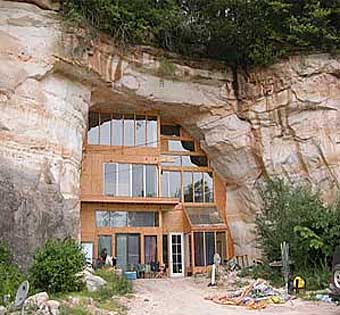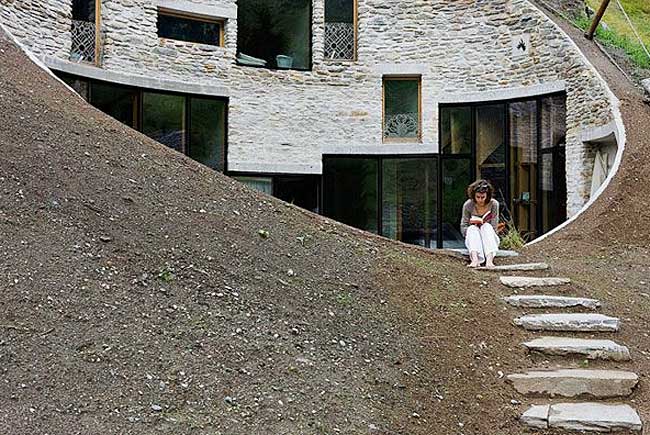Advantages
& Disadvantages
As with any type of dwelling, you'll find advantages and
disadvantages in building underground homes, as well as
in living in them. They offer an ecological answer to
overpopulated suburban areas, and they are quite efficient.
 What are the pros and cons of underground
homes?
What are the pros and cons of underground
homes? |
|
So, there are pluses and minuses to consider when you
look into building one of these unique houses.
As you enter the planning stages, you'll quickly learn
that not many companies build earth-sheltered homes, as
compared to those that build conventional houses. Financing
can also be hard to obtain, unless you find a lender who
has dealt with earth homes before. They are often concerned
about the resale value that an underground house might
have.
Agents of Change ...
Insuring earth-sheltered homes shouldn't be a problem,
since they can withstand almost anything Mother Nature
- or man - can dish out. But once again, insurance agents
may not have insured this kind of housing before.
Once you have your home built, you'll enjoy anywhere from
50 to 95 percent savings in energy to keep your house
warm and cool, as the seasons change. The concrete used
in building underground houses stores heat effectively,
leading to less need for heating units inside.
The temperature inside underground houses is much steadier
than that of traditional homes, and the range of temperatures
is fairly comfortable, even if you don't use an extra
fireplace in the winter or air conditioner in the summer.

Underground Living
Concerning Concerns ...
People who are considering building subsurface houses
do have concerns about sufficient lighting, good building
sites and control of moisture. Earth-sheltered houses
may cost between 10 and 30-percent more to build. But
in return, the house will last much longer than conventional
homes. The concrete used is almost maintenance-free, with
a life of nearly 1000 years.
People also worry that the home itself will be foreboding
and dark. But using the proper site selection and the
optimal design options for your site will allow it to
be light and airy. In addition, you can create light that
looks more natural by using indirect lighting.
Old cellars and basements tended to become musty and humid,
and people fear that this will happen with earth sheltered
homes, as well. But choosing a suitable site and taking
care to use proper drainage and sealing techniques will
allow the humidity to remain within comfortable levels.
Musty odors can be avoided by the use of fans, pumps and
ventilators, to keep the air moving.

If feeling claustrophobic, it may be important
to make frequent trips outside.
The importance of many green and security issues have
factored into the record number of people who are building
underground housing today. Storm protection, energy efficiency,
natural light and low maintenance are all important aspects
of a comfortable home. It's also important to builders
and buyers that green products are used, and that the
landscaping is disturbed as little as possible. Or at
least the home is integrated into the landscaping in a
pleasing manner.
In Summary ...
Usually, when building earth-sheltered homes, it is possible
to conserve the area's natural resources, including land
as well as energy. Most sub-surface home buyers are concerned
with the money they can save by living in a home of this
type. But almost equally important are that these homes
are energy efficient, ecologically friendly and offer
a high amount of security. Once you weigh the advantages
against the disadvantages, you may discover that living
the life of a gopher isn't nearly as bad as you had previously
thought.
Written by Kevin Knatloa
First Published on November 05, 2012
Updated December 09, 2014
|